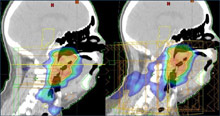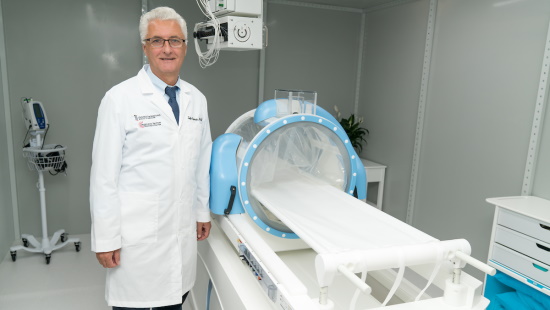RapidArc
RapidArc, which can deliver high dose radiation to tumors two to eight times faster than conventional methods, is offered by the Department of Radiation Oncology at the University of Maryland Marlene and Stewart Greenebaum Comprehensive Cancer Center (UMGCCC).
Advantages for Patients
RapidArc is a major medical advance for treating certain types of cancer with image-guided, intensity-modulated radiation therapy (IG-IMRT). RapidArc is delivered using the Trilogy linear accelerator at UMGCCC.
RapidArc has several important advantages for patients:
- Treatments are fast.
With RapidArc, IMRT treatments that typically require at least 10 minutes can be completed in less than 2 minutes. That means more comfort and less disruption for patients, because they spend less time in their daily treatments. Patients can be in and out of treatment quickly and return to their daily routine. - Treatments accuracy is increased.
Faster RapidArc treatments mean less time that the patient must hold still, and therefore less chance of patient movement that could compromise treatment accuracy. - Higher doses of radiation are delivered to hit the tumor harder.
RapidArc rotates 360 degrees around the patient, enabling the very small beams with varying intensity to be aimed at the tumor from multiple angles. Unlike other forms of radiation therapy, with RapidArc the radiation treatment being delivered to the patient can be adjusted continuously throughout treatment. This results in less radiation exposure to surrounding healthy tissue. - More precise imaging helps target the dose.
RapidArc incorporates technology that makes it possible to position the patient for treatment with sub-millimeter accuracy. An on-board imaging system provides high-resolution X-ray images of the targeted area just before each daily treatment.
Our Expertise: RapidArc Invented by UM Scientist
RapidArc technology was originally invented by Cedric X. Yu, DSc, Mansfield Professor of Radiation Oncology at the University of Maryland School of Medicine and member of the radiologic physics team in the Department of Radiation Oncology at the University of Maryland Marlene and Stewart Greenebaum Comprehensive Cancer Center.
Dr. Yu's research in developing new techniques for radiation therapy delivery has led to a number of important advances in the field in addition to RapidArc. Innovations such as intensity-modulated arc therapy (IMAT), which he invented in 1995, and Direct Aperture Optimization (DAO), an enhancement of IMRT therapy that Dr. Yu helped develop, have led to significant improvements in the care of patients with cancer.


